
PO Box 9021, Wilmington, DE 19809, USA
E-mail: tours@focusonnature.com
Phone: Toll-free in USA, Canada, & Puerto Rico 1-800-721-9986
or 302/529-1876

PO Box 9021, Wilmington, DE
19809, USA
E-mail: tours@focusonnature.com
Phone: Toll-free in USA, Canada, & Puerto Rico 1-800-721-9986
or 302/529-1876
HIGHLIGHTS
FROM FOCUS ON NATURE TOURS in 2010
DURING BIRDING & NATURE TOURS
IN: BRAZIL (2
tours), the CAYMAN ISLANDS, COSTA RICA (2 tours),
MEXICO
(Sonora), JAPAN
(2 tours), & URUGUAY AND IN THE US, TOURS IN: ARIZONA
(2 tours), COLORADO, NEBRASKA, TEXAS, & WYOMING
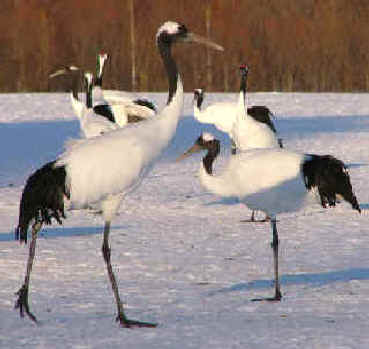
Again, on the snow, during
our January 2010 Japan Tour.
there were Red-crowned, or Japanese, Cranes,
known as "Tanchos".
The tour summaries here are given with the most-recent tours first.
![]() For
some tours there are links below for longer NARRATIVES. Also there
are links to UPCOMING TOUR ITINERARIES, and LISTS relating to BIRDS,
MAMMALS, & OTHER NATURE.
For
some tours there are links below for longer NARRATIVES. Also there
are links to UPCOMING TOUR ITINERARIES, and LISTS relating to BIRDS,
MAMMALS, & OTHER NATURE.
Links to Tours:
CAYMAN ISLANDS (December 2010)
BRAZIL
(far-southern & the Pantanal) & URUGUAY (October 2010)
ARIZONA (southern & central) (August-September 2010)
ARIZONA (northern & central) (August 2010)
JAPAN (May 2010)
TEXAS (MAY 2010)
COLORADO, NEBRASKA & WYOMING (APRIL 2010)
![]()
CAYMAN
ISLANDS - December 2010
This tour in early
December 2010 was to a small, but interesting, island, Grand
Cayman, in the middle of the blue Caribbean Sea. About 200 miles
south of Cuba, and over 150 miles west of Jamaica, that island is out there by
itself, except for the two accompanying islands in the group of 3, Little Cayman
and Cayman Brac.
Of the 3 Cayman Islands, Grand Cayman is, (although as noted as small), the largest
of the 3 with 123 square miles.
Whether perceived as "small" or "large", as already noted
also, Grand Cayman Island
is interesting, with a mix of habitats: dry forest, dry scrubland, seasonally
flooded wetlands, and extensive mangroves.
In that mix on the Cayman Islands, there are, incredibly, 415 types of plants
believed to be native, and among them about 30 that are endemic and about
25 near-endemic. Now, that is interesting!
And that relates to the flora. There's also the fauna. I'll
mention both here, but the flora first:
We saw a number of those native and endemic plants during our tour, including
the Agave caymanensis, Dendrophylax fawcetttii (the critically
endangered Ghost Orchid), Coccothrinax proctorii (the Silver
Thatch - the endemic "national tree" that played such a part
in the island's history), and Hippomane mancinella, the Manchineel,
a tree that, in all of its parts, is very poisonous to man, but with a fruit
that can be eaten by the rare Cayman Blue Iguana.
That reptile is said to be the rarest of the world's iguanas. Native to Grand
Cayman Island, it is now considered to be a subspecies of the Cuban Iguana,
Cyclura nubila lewisi.
Many of the native plants and animals of the Caymans are derived from species on
Cuba, Jamaica, and to a lesser extent, Central America.
Among the amphibians and reptiles during our December
2010 tour, in addition to the iguana, there were, clinging on
large leaves, the Cuban Treefrog, and seen on the ground, the Cuban
Racer, or Ground Snake. The snake was the endemic subspecies on Grand
Cayman Island, Alsophis cantherigerus caymanus.
Among the birds of the Caymans, that we enjoyed during our tour, were
these that occur more commonly in Cuba: the Rose-throated Amazon, Cuban
Bullfinch, LaSagra's Flycatcher, and Western Spindalis.
We saw, nicely, the Yucatan Vireo. Grand Cayman Island is the only place
for that species outside of Mexico and nearby Belize.
The Vitelline Warbler is virtually endemic to the Caymans (otherwise
being only on the isolated Swan Island). And, also during our
tour, we saw about as many as 300 West Indian Whistling Ducks, a species
that globally is rare and elsewhere can be difficult to find.
And there were the unexpected, very unexpected: as we were waiting one
evening, at sunset, for Velvety Free-tailed Bats to leave their
daytime roosting sites, an Eastern Whip-poor-will flew by and a King
Rail called in the nearby tall reeds of a small marsh. Both the whip-poor-will
and the rail are very rare birds in the Caymans (in fact, not even on
the island's bird-list), but they occur in December as either a vagrant in
Cuba and Jamaica (the rail) and (with the whip-poor-will) as a
rarely-observed transient in Cuba on its way to spend the winter by the
Caribbean coast of northern Central America.
Conversely, very easy to observe in the Caymans are butterflies - always
a natural highlight of a visit there, and they were for us again in December
2010, with dozens of Julias (or Flambeaus) at one
place, and a number of other species including the Cuban Red Leaf Butterfly,
Gulf Fritillary, White Peacock, Caribbean Buckeye, the Soldier,
Western Pygmy Blue (possibly the smallest of the world's butterflies),
and the Hanno Blue and Lucas's Blue (closely related to the
rare Miami Blue of south Florida).
Also in the "insect-department" during our December
2010 Cayman Tour, we saw a diurnal moth that looks so much
like a small hummingbird, even having a white band on the lower back as do the
small hummingbirds called coquettes. That moth, that we saw feeding at flowers,
has, of course, a scientific name: Aellopos tantalus. Its English name
is, correspondingly, the Tantalus Sphinx Moth.
And then there was the large caterpillar that we saw that would turn into
a moth. Over 4 inches long, that big, fat caterpillar was, and filled with
color: bright yellow, black, and with a red head. Scientifically it goes by the
name Pseuosphinx tetrio, to be the large Tetrio Sphinx Moth.
During a previous FONT tour in the Caymans, that was in the month of February,
we saw that big moth, flying about after dark, as the headlights of our vehicle
shone on it, when we were on a dark back road. That road, by the way, was not
far, as the moth would fly, from where we saw the caterpillar, a couple years
later, in December
2010.
We look forward, in the years ahead, to going to the Cayman Islands again for the fine assortment of
nature to be had there, on a Caribbean island both pleasant and comfortably
warm.


Two of the butterfly species
during our December 2010 Cayman Tour,
the Julia (above) & the White Peacock (below).
Links:
A List of Birds & Other Nature during the FONT Cayman Islands Tour in December 2010
Cumulative List of Birds during FONT Tours in the Cayman Islands
Butterflies in the West Indies of the Caribbean
Amphibians & Reptiles in the West Indies of the Caribbean
![]()
BRAZIL
(far-southern & the Pantanal) & URUGUAY - October 2010
This tour, mostly in Brazil,
was in the southernmost state in that big country - the state known as Rio
Grande do Sul.
Also visited was the southernmost of the two Brazilian states containing the Pantanal
- that state , Mato Grosso do Sul. Both of
those "southern states" ("do Sul") are bird-rich. Also
during our October 2010 tour, we spent parts
of two days in Uruguay, where we saw many
birds as well.
We've been in both of the "do Sul" states during previous FONT tours, and like to go back, because for birds there is so much to see and enjoy.
In Rio Grande do
Sul, in October 2010, there were, as there have been for us in the past: large numbers of waterbirds,
notably including screamers, swans, ducks, spoonbills, limpkins, ibises,
herons, and egrets, and gulls and terns. Shorebirds
were also in good supply, as were some birds of prey. Particularly notable among
the ducks was the beautiful Ringed Teal.
Particularly notable among the birds of prey were two species of Harriers,
the Long-winged and the Cinereous. And the Snail Kites were
so abundant that we probably saw more in a few days than we probably would
otherwise in our lives.
Most of the big flocks of birds were in southern Rio Grande do Sul, but birding was also exceptional for us further north in the state, where we visited some beautiful habitat in the "high campo" with some wonderful remnants of Araucaria ("Monkey-puzzle") trees.
Not just common birds, but some rare birds were enjoyed in Rio Grande do Sul, including the very-local Long-tailed Cinclodes (described as recently as 1969), the Black-and-white Monjita, and another rarity with which it has a symbiotic relationship, the Saffron-cowled Blackbird. That blackbird was not the only special member of its tribe during our tour. We were also treated to the Scarlet-headed Blackbird, another fine bird to see.
In Mato Grosso do Sul, there were mammals, in addition to birds, including 5 Giant Anteaters (1 a mother with a baby on her back), and 2 Ocelots that we saw wonderfully well. These animals were seen after dark on excursions, during which Striped Owls and various nightjars were also seen nicely.
A complete list of the about 290 species of birds, along with more regarding our October 2010 tour in Brazil, and in Uruguay, can be found thru the links below - including why Uruguay was such a nice and interesting place to visit.
Links:
List
of Birds & Other Wildlife during the FONT Brazil Tour - October 2010
A
Complete List of Brazil Birds, noting those during previous FONT tours, in 3
parts:
Part #1: Tinamous to Doves
Part #2: Macaws to Flycatchers
Part #3: Antshrikes to Grosbeaks
Rare Birds during FONT Tours in Brazil (with some photos)
Mammals & Some Other Wildlife during FONT Brazil Tours (with some photos)
Upcoming FONT Birding & Nature Tours in Brazil
![]()
Arizona (southern & central) - August/September 2010
This was the third of
our three consecutive tours in Arizona and northern
Mexico in the late summer of 2010.
During this tour, collectively, it was the hummingbirds were the avian
stars, with 13 species of them seen, and one hybrid.
The hummers were: Broad-billed, Berylline, Violet-crowned,
White-eared, Blue-throated, Magnificent, Lucifer, Black-chinned, Anna's,
Costa's, Calliope, Broad-tailed, and Rufous.
One has the name Magnificent, but really, in their own way, they all are!
We saw Violet-crowned Hummingbirds at two places.
We saw more than one White-eared Hummingbird.
The male Anna's, as always, are exceptionally brilliant.
The Calliope was the smallest.
And the Costa's, the "desert hummingbird", was the last of our
hummers to be seen - a female. Males, "according to the books" wander
away in early September to be "elsewhere".
The Rufous Hummingbird, it is now known, is a hummer that truly wanders
on its little wings. From Alaska to Mexico, and some east to Florida and
elsewhere.
What fascinating birds the hummingbirds are!
What was particularly nice for us, in the "hummingbird department",
during our Aug/Sep 2010 tour, were both male
and female Lucifer Hummingbirds. That species now, by the way, has a new
name, the Lucifer Sheartail. Whatever its second name, as its
first name implies, it can be "a devil" of a bird to find. Again, we
were so glad when we saw it as well as we did.
The hybrid that we saw was a Costa's-Anna's.
Another highlight of the tour that we saw so well was not a bird. It was a Bobcat,
that we saw during the day, as it was "perched" mostly behind foliage
by a large branch in a small tree.
Close to us it was, and not ever moving away, even as it was photographed from
various positions. Its eyes followed our movements, and as its head turned we
saw its wonderful long white whiskers.
What an encounter it was for us, that sunny morning, prior to our actually
leaving the Bobcat where it was, still resting in the small
tree.
Links:
Birds & Other Wildlife during FONT tours in Arizona, USA & Sonora, Mexico in Aug/Sep 2010
Photos from the FONT Arizona & Sonora, Mexico Tours in Aug/Sep 2010
A List & Photo Gallery of Arizona Birds, in 2 Parts:
Part 1: Quails to Becard
Part 2: Flycatchers to Buntings
Mammals of Arizona (with some photos)
Amphibians
& Reptiles of Arizona (with some photos)
Butterflies and Dragonflies & Damselflies of Arizona
(with some
photos)
Plants of the Desert & Some Nearby Habitats (with some photos)
A Photo Gallery of Hummingbirds
Upcoming FONT Birding & Nature Tours in Arizona
![]()
Mexico (Sonora) - August 2010
During the last
week of August 2010, this tour was mostly in two areas in the
northern Mexican state of Sonora.
One area was inland, in remote hills just west of the mountains known as the Sierra
Madre, at a ranch where we've stayed in the past.
Many Ocotillos were among the plants covered those hills, and in which of
course there were birds of various kinds. In canyons, birds included Rufous-capped
Warblers (we saw 3 at once) and Elegant Trogon.
Mammals included the big Antelope Jackrabbits that we saw,
and the Coyotes that we heard. There were more butterflies than
imaginable. And after the sun set, as we were no where near any populated area,
the stars in the sky above seemed to jump out at us.
The other particular area that we visited during this tour in Sonora
was a place along the Gulf of California
(also known as the Sea of Cortez). That
place, a great place for birds, was Kino Bay
(also called, in Spanish, Bahia de Kino).
It's a great place for birds as there are so many, with a large number of
species, and some of them were in large numbers. Notable among
the birds, for us, were both Blue-footed and Brown Boobies, Yellow-footed
and Heermann's Gulls, and Black Storm Petrels.
During one boat-ride, offshore, we circled and then visited an island where
there were only birds, thousands of them. And shells, and other
remnants of life washed up from the sea such as a whalebone, a head of a shark,
and the skull of a parrotfish. Swarms of Magnificent Frigatebirds were in
the air (at least a couple thousand). Around the periphery of the rocky island,
there were thousands of gulls, pelicans, and cormorants, and some shorebirds.
On the cliffs, and on the water and in the air nearby, there were the boobies.
The other boat-ride was on the large estuary, where again birds were in the
thousands. Among them, there were many godwits and curlews, sandpipers,
and long-legged waders of various sorts. In that area of Kino
Bay, during one afternoon, we saw as many as 7 species of terns.
It was so nice to see so much during our time by the
sea.
Links:
Birds & Other Wildlife during our tours in Arizona, USA & Sonora, Mexico in Aug/Sep 2010
Photos from the FONT Arizona & Sonora, Mexico Tours in Aug/Sep 2010
Birds
of Mexico, part
1: Tinamous to Shorebirds (with
some photos)
Birds of Mexico, part 2: Jaegers to Woodpeckers (with some photos)
Birds of Mexico, part 3: Manakins to Buntings (with some photos)
Mammals of Mexico (with some photos)
Upcoming FONT Birding & Nature Tours in Mexico
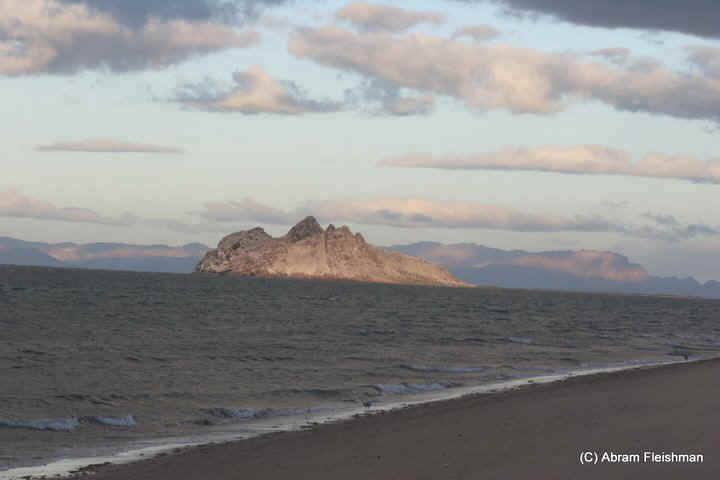
Above: The
island called Alcatraz (or "Pelican")
that we visited when we went to the Sea of Cortez
during our August 2010 tour in Sonora, Mexico.
At the island, in addition to the many pelicans,
we saw both Blue-footed and Brown Boobies,
and swarms of Magnificent Frigatebirds,
Double-crested Cormorants, and Yellow-footed Gulls.
(photo by Abram Fleishman)
![]()
Arizona (northern & central) - August 2010
This was the first of
three back-to-back FONT tours in Arizona and
nearby Mexico (in Sonora).
In mid-August 2010, it was in northern and central parts of Arizona,
with places visited including the Grand Canyon,
the Petrified Forest,
and the Painted Desert.
Highlights, among the birds, included 3 California Condors seen closely
as they flew above us, and a Prairie Falcon on a telephone pole,
perched near us.
The condors were at the Grand Canyon, which is, of course, itself
spectacular. The falcon was on Navajo land, near the Petrified Forest and
Painted Desert area which was a fascinating region to visit.
Among a nice variety of birds during this tour, in an enjoyable area of Arizona
to visit, there were others of note in addition to the condors and falcon,
including both Zone-tailed and Common Black Hawks and a large
flock of Pinyon Jays. In addition to the birds, there was a varied
assortment of mammals (including Pronghorn), butterflies,
and wildflowers and other plants.
Birds of the dessert that we saw nicely included the LeConte's Thrasher
and Abert's Towhee, in addition to a bird that's always a favorite, the Greater
Roadrunner.
Links:
Birds & Other Wildlife during our tours in Arizona, USA & Sonora, Mexico in Aug/Sep 2010
Photos from the FONT Arizona & Sonora, Mexico Tours in Aug/Sep 2010
A List & Photo Gallery of Arizona Birds, in 2 parts:
Part 1: Quails to Becard
Part 2: Flycatchers to Buntings
Mammals of Arizona (with some photos)
Amphibians
& Reptiles of Arizona (with some photos)
Butterflies and Dragonflies & Damselflies of Arizona (with some
photos)
Plants of the Desert & Some Nearby Habitats (with some photos)
A Photo Gallery of Hummingbirds
Upcoming FONT Birding & Nature Tours in Arizona
![]()
Our spring tour in Japan in
May
2010 was the 34th FONT tour in that country, and the 7th to include
Hegura, a
small island in the Sea of Japan that is an outstanding place for bird migration
in the spring - one of the best such places anywhere in the world.
Other places that were visited on the main Japanese island of Honshu included
the Japan Alps, the rural Noto
Peninsula, and forested
hills in central Honshu and reed beds and rice fields in the eastern
part of the island.
Links:
More about the FONT Japan Tour in May 2010
Birds & Other Wildlife during our Japan Spring Tour - May 2010
Cumulative List of Birds during our Japan Tours (with some photos)
Birds during FONT tours on Hegura Island (with some photos)
Upcoming FONT Birding & Nature Tours in Japan
![]()
Our tour in the big state of Texas in
May 2010 was in the south-central part of
the state, from the Gulf Coast to the Hill
Country.
In that area, we met with a nice array of birds, including, along the coast,
Piping Plover and Black Rail. Eastern migrants were seen as well, including
warblers of various kinds in small trees by the salt marsh and sand dunes. A
small tree there was filled with orioles during their migration.
In the Austin area, for birds, "east meets west". From the city east:
Ruby-throated Hummingbird, Blue Jay, and Red-bellied Woodpecker. From the city
west: Black-chinned Hummingbird, Western Scrub Jay, and Golden-fronted
Woodpecker.
Of course, from Austin west, in the "Hill Country"
of the
Edwards Plateau, there are the two special birds of the region, the
Golden-cheeked Warbler, and the Black-capped Vireo. The Golden-cheeked
Warbler
only nests in Texas; the Black-capped Vireo nearly so.
Among the mammals during the tour were the thousands upon thousands of Mexican
Free-tailed Bats that fly at dusk from caves and even a city bridge. Other
mammals included: Gray Fox, Wild Boar (that has become established in some wild
parts of Texas), Black-tailed Jackrabbit, and raccoon, deer, and
opossum. Other
wildlife included: American Alligator, and various turtles and snakes.
Wildflowers were absolutely in profusion. Butterflies were plentiful.
Links:
More
about the FONT Tour in Texas in May 2010
Birds & Other Wildlife during our Texas Tour in May 2010
A Complete List of Texas Birds
Texas Birds during FONT tours (with some photos)
List
of Texas Mammals (with some photos)
List
of Texas Butterflies (with some photos)
Plants
of the Desert & Some Nearby Habitats
(with some photos)
Upcoming FONT Birding & Nature Tours in Texas
![]()
Colorado,
Nebraska, & Wyoming - April 2010
During this tour, in April
2010,
we traveled in the plains of eastern Colorado and
Nebraska, and in the mountains
of central Colorado and nearby Wyoming,
in our quest to see birds and animals, and especially among the
birds, the various grouse of the region.
All of the grouse that we sought were seen well, including: in Colorado, the Gunnison
Sage Grouse, the Lesser Prairie Chicken, the Greater Sage Grouse,
and the Dusky (formerly Blue) Grouse, and in
Nebraska, the Greater
Prairie Chicken and the Sharp-tailed Grouse.
A good number of other birds (about 130 species in all), and some interesting mammals were also seen (among over 20 species of them).
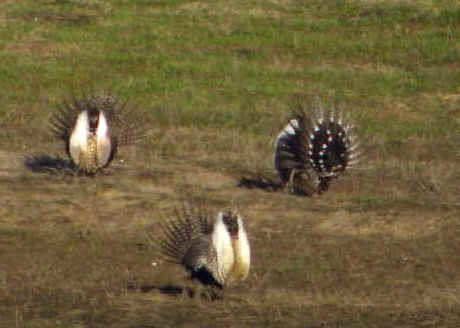
Greater Sage Grouse in
Colorado in April 2010
(photo courtesy of Andre from Canada)
Links:
More about the FONT Tour in Colorado, Nebraska, & Wyoming in April 2010
Birds & Other Wildlife during our Tour in Colorado, Nebraska, & Wyoming in April 2010
Birds & Other Wildlife during FONT Tours in Colorado & nearby states in April
Birds
during FONT Tours in Colorado & nearby states (with some photos)
Birds during FONT tours in Nebraska
A
Feature - the Grouse of Colorado & Kansas
Mammals during FONT tours in Colorado & nearby states (with some photos)
Upcoming FONT Birding & Nature Tours in Colorado & nearby States

Sightings of Pronghorns
were especially numerous during our tour
in Colorado & nearby states in April 2010.
![]()
During the FONT tours in Costa Rica in March 2010, over 400 species of birds were found.
Mammals, during the tour, included: the Northern Tamandua (or Collared Anteater), the White-nosed Coati, 3 kinds of Monkeys (the Central American Spider, the Mantled Howler, and White-faced Capuchin), and a wild cat called the Jaguarundi.
Among the more than 400 bird
species, there were many highlights.
During our Northern Costa Rica Tour, there
were both Great Green and Scarlet
Macaws, the Agami Heron, 2 Jabirus (in the large bird
department), while
in the small bird department there a number of antbirds, including
the Ocellated, Bicolored,
and the Spotted.
Some of the birds had the
adjective Great, and they were these, all seen:
Great Tinamou, Great Potoo, and Great Curassow, with both male and
female nicely seen of the
last of these.
In far-northern Costa Rica, not far from Nicaragua, 2 species of birds were seen with the adjective Nicaraguan: the Nicaraguan Grackle and the Nicaraguan Seed-Finch, with its huge pink bill.
During our Southern
Costa Rica Tour, certainly outstanding were the Resplendent
Quetzals that we saw so nicely on tree branches in the cloud forest,
when it was not cloudy or misty, but rather as the sunshine accentuated
all the more the beauty of the birds.
27 species of hummingbirds were seen during the March 2010 FONT Costa Rica tours,
mostly in the southern part of the country. Truly there was a collective splash of color
with the half-dozen or so Fiery-throated Hummingbirds, at one time, at one feeder, in
the mountains. A throat or a gorget could not be more colorful anywhere than were
those of bright red, orange, and yellow.
Elsewhere, during our Southern Costa Rica tour, another hummingbird was a
showstopping star
as a solo. It was the small, brilliantly attractive, mostly maroon-colored male
hummingbird known as the Snowcap.
Also in Southern
Costa Rica, we visited the home of the renowned naturalist, Alexander
Skutch, for the first time for us since he died, after living a century.
He passed away shortly after the current century began. We visited his
place and him, during some of our previous tours, but until now, in 2010,
we did not go back after he passed away.
Three times during our previous
visits with Mr. Skutch, we enjoyed, with him,
the sight of a Turquoise Cotinga atop a tree. This time, in March 2010,
when we went to the same porch as we had in the past, there, once again,
was a Turquoise Cotinga at the top of a tree. With that, for us, the
spirit of Alexander Skutch lived
on.
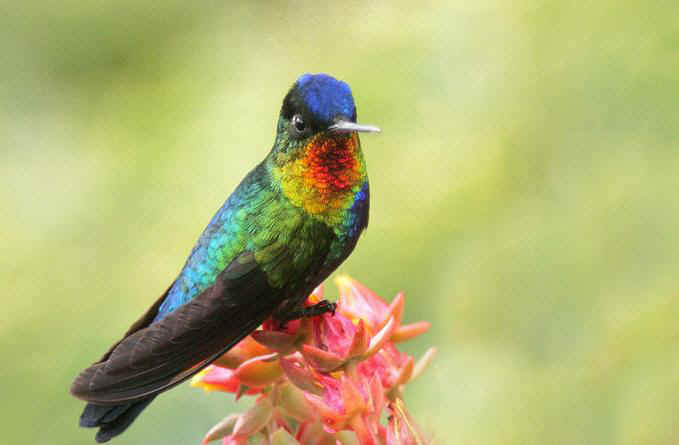
The Fiery-throated Hummingbird
If there's this much color on one bird,
imagine how much with 6 or more of them together!
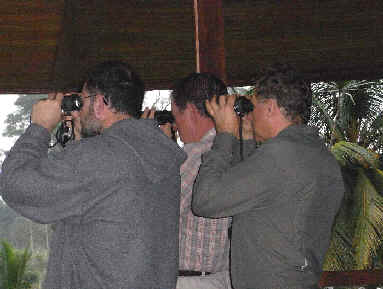
FONT tour participants birding at breakfast
at Laguna del Lagarto, Costa Rica, in March 2010
(photo by Britta Biebach of Berlin, Germany)
Links:
More about the FONT Costa Rica Tours in March 2010
Lists of Birds & Other Wildlife during the FONT Costa Rica tours - March 2010
Costa Rica Birds (a list of 863 bird species; about 700 during FONT tours- with some photos)
Costa Rica Birds during northern Costa Rica tours (605 species)
Costa Rica Birds during southern Costa Rica tours (493 species)
A Photographic Sampling of Colorful Costa Rican Birds
A
Feature about Alexander Skutch, a naturalist in Costa Rica
Upcoming FONT Birding & Nature Tours in Central America
![]()
During this tour, in Amazonian Brazil, included a place with both Hoatzin & Harpy - Harpy Eagle, that is. It was a place in a system of Amazon waters, where we traveled mostly by boat along rivers and channels, but also where we hiked on trails in the rainforest.
Among our favorite birds were the Agami Heron and Horned Screamers, which were in addition to a good assortment of raptors, parrots and parakeets, toucans, and trogons. Small birds that were nice to see were the hummingbirds, manakins, and near us on a branch in the forest, a tame little creature with an odd name, the Dwarf Tyranneutes (formerly known as the Dwarf Tyrant-Manakin).
But the best of our more than 200 species of birds was the Guianan Cock-of-the-Rock. Not only did we see so very well the brilliantly-colored orange males, like beacons in the forest, we enjoyed the rare sight of a dark, nearly-black, female Cock-of-the-Rock sitting on its nest, on a ledge of a big rock, at a grotto by the entrance to a cave, in which, during the day, numerous bats were roosting. On the soft ground below, there were tracks of an Ocelot.
Other mammals during the tour included various monkeys: the Red-handed Tamarins, Bare-eared Squirrel Monkeys, White-nosed Bearded Sakis, Brown Tufted Capuchins, and the noisy Red Howler Monkeys. In the water, we saw both Gray Dolphins and Pink River Dolphins. The Amazonian Manatee was there also.
Among other birds (too many to note here), a few, however, should be mentioned, including: the hollering of a group of Red-throated Caracaras, along with the raucous calls of macaws, that late one afternoon, made the normally loud Mealy Amazons and Red-fan Parrots seem rather quiet by comparison.
Links:
List of Birds & Other Wildlife during the FONT Brazil Tour - February 2010
A
Complete List of the Birds of Brazil:
Part 1: Tinamous
to Flycatchers
Part 2: Antshrikes to Grosbeaks
Rare Birds during FONT Tours in Brazil (with some photos)
Mammals & Other Wildlife in Brazil (with some photos)
Upcoming FONT Birding & Nature Tours in Brazil
![]()
Japan - January 2010
The 33rd FONT birding & nature tour in Japan took place in
January 2010.
During that tour, a wild creature was seen for the first time during any of our
tours in Japan. On the northernmost Japanese island of Hokkaido, at the
easternmost place in Japan, seen from shore were 2 Sea Otters. At another place
in eastern Hokkaido, late that same day, as many as 1,000 Sika Deer were seen.
And these in that part of Japan were in addition to the avian cast of characters
that we've always enjoyed seeing, the eagles, both Steller's Sea Eagles
and
White-tailed Eagles, both seen closely, and the cranes, the Red-crowned, or Japanese,
Crane, that were again
as stately as they've always been for us, on the
snow.
Among the numerous waterfowl that we saw during the tour were 2 species of
swans, 2 species of geese, and numerous ducks. Notably beautiful among the last
of these were the Mandarin, Falcated, Long-tailed, and Harlequin
Ducks, and Smew. Of
each of these, we had wonderful sightings.
Other interesting and enjoyable sightings during the tour included: Japanese
Macaques (or "Snow Monkeys"), Pallas' Rosefinch, Red-flanked
Bluetail,
and many Daurian Redstarts and Brown Dippers.
Links:
Birds & Other Wildlife during FONT Japan Tour in January 2010
Cumulative List of Birds during FONT Japan Tours (with some photos)
Rare Birds during FONT Tours in Japan
Upcoming FONT Birding & Nature Tours in Japan

During the FONT Japan Tour in
January 2010,
2 Sea Otters, known as Rakkos, were seen
from shore in eastern Hokkaido.
The Sea Otter is very rare in Japan.
Only 2 or 3 dozen are said to exist
in the nearby islands
that are part of Russia.
![]()